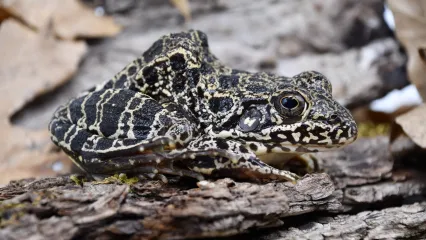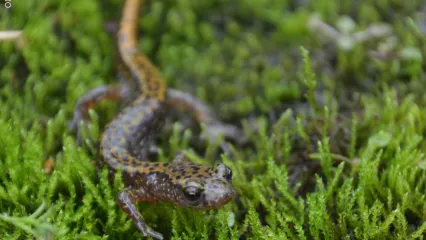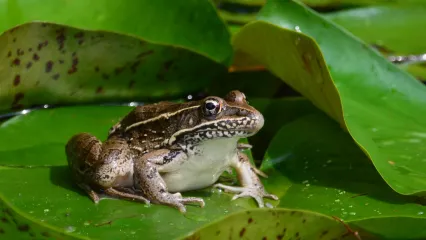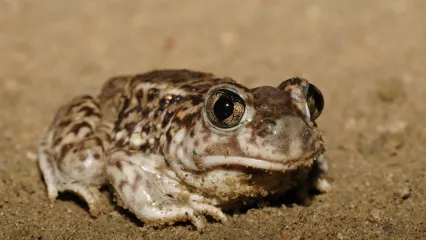
Description
The crawfish frog is a medium-sized, robust frog. Its back has a beautiful reticulated pattern of large dark brown spots outlined in light tan on a brown background. The light skin bordering the spots is sculpted, providing an overall rough dorsum. Light tan raised dorsolateral folds occur on the sides of the back. The folds may be continuous in some individuals but broken in others. The venter is white, and the hidden areas in the groin are yellow. Males have a large tympanum, which may be about one half or more the size of the eye.
Tadpoles of the crawfish frog can reach 2 to 2.5 inches before transforming into froglets. They are brown with darker brown mottling. They generally remain as tadpoles for at least two months before metamorphosis.
The crawfish frog call is a low snore. Although not a loud call, a large chorus can be heard from a long distance. These frogs are very sensitive to movement and cease calling at the slightest disturbance.
Size
Individuals range in size from 2.5 to 4 inches in length. Males are smaller than females. Newly metamorphosed juveniles are about 1.25 inches in length.
Habitat
In Oklahoma, crawfish frogs occur throughout most of the eastern half of the state, although the distribution may be localized. Within the U.S., these frogs occur from Louisiana and eastern Texas, through eastern Oklahoma and eastern Kansas, to southern Illinois and Indiana. Their distribution is disjunct, and they are absent throughout much of Missouri and Arkansas.
Life Cycle
Crawfish frogs are late winter or early spring breeders. In Oklahoma, they breed in early to mid-February. Breeding is generally explosive. Males begin moving soon after heavy rains flood temporary ponds. Most breeding occurs within a two- to three-week period, although sporadic breeding choruses may be heard until April. Breeding sites include many kinds of small bodies of water, including temporary ponds, roadside ditches, and flooded pastures. Circular clutches of 2,000 to 7,000 eggs are deposited in shallow water; hatching occurs within 7 to 10 days depending on temperature.
Crawfish frogs feed on many insects, spiders, and possibly crayfish.
How To Observe
Crawfish frogs remain underground most of the time and are thus secretive and difficult to observe. During the non-breeding season, they use abandoned crawfish burrows or other animal burrows for shelter, seldom coming to the surface. Locating them by their calls during the brief breeding season is a reliable way to observe them, although they quickly retreat to the nearest burrow upon being approached. Occasionally, individuals may be seen crossing roads on rainy evenings during breeding migrations.
(This profile was created by Dr. Laurie Vitt as part of a partnership between the Wildlife Department and the Sam Noble Oklahoma Museum of Natural History. It was funded as part of a larger State Wildlife Grant to survey and inventory amphibians and reptiles of the Wildlife Management Areas of Oklahoma: T-35-P-1.)


